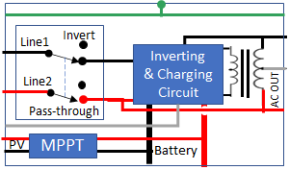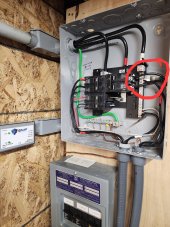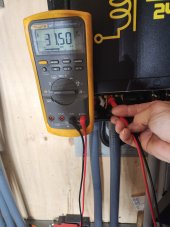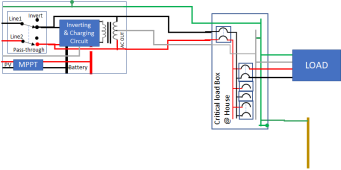You are using an out of date browser. It may not display this or other websites correctly.
You should upgrade or use an alternative browser.
You should upgrade or use an alternative browser.
EG4 6000EX - Double Ground/Neutral
- Thread starter HLD
- Start date
sunshine_eggo
Happy Breffast!
<Insert here: My long-winded angry rant about how MPP, Growatt and EG4 provide shit-poor documentation about their products>
Going to throw Victron in there as well. Anything regulatory/code compliance - they push you to your local installer. Grounding falls squarely in this category - "refer to your local requirements."
Fortunately, with digging, one can find that with two VE.Bus inverters operating in parallel, one is configured with the GNB relay closed, and the other's relay is set to open, thus, you only have one GNB. If fed from AC input, the single GNB relay opens. If inverting, closed.
FilterGuy
Solar Engineering Consultant - EG4 and Consumers
Well, if they come after me, I have a long email trail of messages to them pointing out the issues and asking for clarifications. I will certainly try to take them down with me. (I also have an email trail with sig solar)
I have been accused of being smart, but I have never been accused of being wise....
I have been accused of being smart, but I have never been accused of being wise....
FilterGuy
Solar Engineering Consultant - EG4 and Consumers
The local requirements can change from one town to the next town over, so I can understand and accept why a manufacturer would act as Vctron does. What is different about Victron is that you can clearly understand how their system works and someone can build safely when armed with that information. The lack of documentation is what bugs me about MPP, EG4, and Growatt. They do not provide the information needed to know what is necessary to make it safe and/or meet the code requirements. If they would just clearly state what is supported and how the product works, a competent person can figure out if it can be used in a safe way that meets the code requirments.Going to throw Victron in there as well. Anything regulatory/code compliance - they push you to your local installer. Grounding falls squarely in this category - "refer to your local requirements."
Fortunately, with digging, one can find that with two VE.Bus inverters operating in parallel, one is configured with the GNB relay closed, and the other's relay is set to open, thus, you only have one GNB. If fed from AC input, the single GNB relay opens. If inverting, closed.
sunshine_eggo
Happy Breffast!
Well, if they come after me, I have a long email trail of messages to them pointing out the issues and asking for clarifications. I will certainly try to take them down with me. (I also have an email trail with sig solar)
I have been accused of being smart, but I have never been accused of being wise....
Hmm... If "ass" comes after "wise," I hear that a lot. I'm starting to think folks may not be flattering me as much as I thought...
FilterGuy
Solar Engineering Consultant - EG4 and Consumers
We have kinda gone off into the weeds. It is fun but I would like to bring the discusion back on topic.
If someone with a unit could do the following test it would be very helpful
Conditions: Put the inverter into inverter/battery mode with no load on the output.
* No AC input,
* Inverter on and running from battery,
* no loads or other connections on the output
Test:
What is the voltage from neutral-out to ground?
Results:
* If the voltage is more than a volt or so, it would indicate (prove?) there is no bond while in inverter mode. (A bonded neutral would definitely show zero or near zero volts)
* If the voltage is close to zero, it is a weak indication that there is a bond but does not prove very much. If the neutral is bonded to ground, the voltage would zero. However, the voltage of a floating center tap could be also be zero....or it could be quite high.
ALSO: Has anyone opened a unit up? Has anyone seen neutral bonding screws?
If someone with a unit could do the following test it would be very helpful
Conditions: Put the inverter into inverter/battery mode with no load on the output.
* No AC input,
* Inverter on and running from battery,
* no loads or other connections on the output
Test:
What is the voltage from neutral-out to ground?
Results:
* If the voltage is more than a volt or so, it would indicate (prove?) there is no bond while in inverter mode. (A bonded neutral would definitely show zero or near zero volts)
(Previous tests in pass-through mode showed a 24V differential between neutral and ground. That test proved there is no bond while in passthrough mode. If there is no bond while in inverter mode and no bond in passthrough mode, then there is no dynamic bonding)
* If the voltage is close to zero, it is a weak indication that there is a bond but does not prove very much. If the neutral is bonded to ground, the voltage would zero. However, the voltage of a floating center tap could be also be zero....or it could be quite high.
ALSO: Has anyone opened a unit up? Has anyone seen neutral bonding screws?
We have kinda gone off into the weeds. It is fun but I would like to bring the discusion back on topic.
If someone with a unit could do the following test it would be very helpful
Conditions: Put the inverter into inverter/battery mode with no load on the output.
* No AC input,
* Inverter on and running from battery,
* no loads or other connections on the output
Test:
What is the voltage from neutral-out to ground?
Results:
* If the voltage is more than a volt or so, it would indicate (prove?) there is no bond while in inverter mode. (A bonded neutral would definitely show zero or near zero volts)
(Previous tests in pass-through mode showed a 24V differential between neutral and ground. That test proved there is no bond while in passthrough mode. If there is no bond while in inverter mode and no bond in passthrough mode, then there is no dynamic bonding)
* If the voltage is close to zero, it is a weak indication that there is a bond but does not prove very much. If the neutral is bonded to ground, the voltage would zero. However, the voltage of a floating center tap could be also be zero....or it could be quite high.
9
ALSO: Has anyone opened a unit up? Has anyone seen neutralI w bonding screws?
I will get on that sometime after I have my coffee this morning. As for opening that unit I can't do that due to warranty issues and since SS has not gave me permission to do so.We have kinda gone off into the weeds. It is fun but I would like to bring the discusion back on topic.
If someone with a unit could do the following test it would be very helpful
Conditions: Put the inverter into inverter/battery mode with no load on the output.
* No AC input,
* Inverter on and running from battery,
* no loads or other connections on the output
Test:
What is the voltage from neutral-out to ground?
Results:
* If the voltage is more than a volt or so, it would indicate (prove?) there is no bond while in inverter mode. (A bonded neutral would definitely show zero or near zero volts)
(Previous tests in pass-through mode showed a 24V differential between neutral and ground. That test proved there is no bond while in passthrough mode. If there is no bond while in inverter mode and no bond in passthrough mode, then there is no dynamic bonding)
* If the voltage is close to zero, it is a weak indication that there is a bond but does not prove very much. If the neutral is bonded to ground, the voltage would zero. However, the voltage of a floating center tap could be also be zero....or it could be quite high.
ALSO: Has anyone opened a unit up? Has anyone seen neutral bonding screws?
We have kinda gone off into the weeds. It is fun but I would like to bring the discusion back on topic.
If someone with a unit could do the following test it would be very helpful
Conditions: Put the inverter into inverter/battery mode with no load on the output.
* No AC input,
* Inverter on and running from battery,
* no loads or other connections on the output
Test:
What is the voltage from neutral-out to ground?
Results:
* If the voltage is more than a volt or so, it would indicate (prove?) there is no bond while in inverter mode. (A bonded neutral would definitely show zero or near zero volts)
(Previous tests in pass-through mode showed a 24V differential between neutral and ground. That test proved there is no bond while in passthrough mode. If there is no bond while in inverter mode and no bond in passthrough mode, then there is no dynamic bonding)
* If the voltage is close to zero, it is a weak indication that there is a bond but does not prove very much. If the neutral is bonded to ground, the voltage would zero. However, the voltage of a floating center tap could be also be zero....or it could be quite high.
9
ALSO: Has anyone opened a unit up? Has anyone seen neutralI w bonding screws?
We have kinda gone off into the weeds. It is fun but I would like to bring the discusion back on topic.
If someone with a unit could do the following test it would be very helpful
Conditions: Put the inverter into inverter/battery mode with no load on the output.
* No AC input,
* Inverter on and running from battery,
* no loads or other connections on the output
Test:
What is the voltage from neutral-out to ground?
Results:
* If the voltage is more than a volt or so, it would indicate (prove?) there is no bond while in inverter mode. (A bonded neutral would definitely show zero or near zero volts)
(Previous tests in pass-through mode showed a 24V differential between neutral and ground. That test proved there is no bond while in passthrough mode. If there is no bond while in inverter mode and no bond in passthrough mode, then there is no dynamic bonding)
* If the voltage is close to zero, it is a weak indication that there is a bond but does not prove very much. If the neutral is bonded to ground, the voltage would zero. However, the voltage of a floating center tap could be also be zero....or it could be quite high.
ALSO: Has anyone opened a unit up? Has anyone seen neutral
@FilterGuy When I did the test yesterday, I had to remove the NG bond on my panel(this panel is where I have both inverters output going prior to the main panel) while I was reinstalling the bond I noticed real light sparks as I was tightening the ground screw. As such I checked with my meter and did not notice any apps on it if any it was somewhere around 0.001 but the voltage was around 24 to 25volts. See pics attached. Also if you notice to the left of the panel I have a EMP Shield the led's on that unit turned off when I removed that bond it has a 3/1 connection when any 1 of those conductors are removed it won't be operational. When I do the test this morning I will have to remove that bond again and will also pay attention to that EMP Shield and see if it picks up on the so called inverter bond.
Attachments
It seems like with one Victron inverter the dynamic switching would be correct when the installation includes an AC IN and bypass mode, but with two inverters in parallel and only one switched, two ground paths would exist, one via the switched Victron bonded neutral and one via the bonded neutral at the main panel where the inverters are connected to that panel via the AC IN and the inverters are in inverter mode (not bypass).Going to throw Victron in there as well. Anything regulatory/code compliance - they push you to your local installer. Grounding falls squarely in this category - "refer to your local requirements."
Fortunately, with digging, one can find that with two VE.Bus inverters operating in parallel, one is configured with the GNB relay closed, and the other's relay is set to open, thus, you only have one GNB. If fed from AC input, the single GNB relay opens. If inverting, closed.
In short, shouldn’t both inverters switch bonding dynamically between bypass and inverter mode for a split-phase install with bypass mode?
(I saw a Will Prowse video about this issue with a split phase Victron install, but I can’t remember which one or what he said. I vaguely recall that he initially had the load center on the output side bonded or floating and hr reversed that after finding out that the Multiplex has dynamic switch, and I’m guessing he had LC bonded initially. Either way, I also recall that the install included a bypass mode AC inverter input.)
Ok I removed the NG bond in the panel output off at panel, inverters on battery/very little solar(its raining) and voltage is 31+ as shown on picture, when I reinstall the NG bond in panel I read mV. That totally odd that would mean no internal bond?.
Also my EMP Shield led turned off with my NG bond removed and back on after I reinstalled the bond.
Also my EMP Shield led turned off with my NG bond removed and back on after I reinstalled the bond.
Attachments
PreppenWolf
Solar Wizard
- Joined
- Oct 10, 2022
- Messages
- 941
That means there is no bond.
FilterGuy
Solar Engineering Consultant - EG4 and Consumers
OK folks I am increasingly convinced this model of the inverter is reasonably accurate:Ok I removed the NG bond in the panel output off at panel, inverters on battery/very little solar(its raining) and voltage is 31+ as shown on picture, when I reinstall the NG bond in panel I read mV. That totally odd that would mean no internal bond?.
Also my EMP Shield led turned off with my NG bond removed and back on after I reinstalled the bond.

* The output transformer acts as an isolation transformer in inverter mode and an autotransformer in bypass mode
* The neutral is generated by the center tap in both modes
* There is no dynamic bonding
Since the NEC requires the neutral of an autotransformer be tied back to the neutral of the original power source the system should be hooked up like this:

This creates a common-neutral layout so the only bond needed in the system is the Main System Bond in the Main Breaker Box
John Frum
Tell me your problems
- Joined
- Nov 30, 2019
- Messages
- 15,230
OK so these units are not suitable for a mobile setup.OK folks I am increasingly convinced this model of the inverter is reasonably accurate:
View attachment 127195
* The output transformer acts as an isolation transformer in inverter mode and an autotransformer in bypass mode
* The neutral is generated by the center tap in both modes
* There is no dynamic bonding
Since the NEC requires the neutral of an autotransformer be tied back to the neutral of the original power source the system should be hooked up like this:
View attachment 127198
This creates a common-neutral layout so the only bond needed in the system is the Main System Bond in the Main Breaker Box
Last edited:
FilterGuy
Solar Engineering Consultant - EG4 and Consumers
Not easily.OK so these units are not usable in a mobile setup.
John Frum
Tell me your problems
- Joined
- Nov 30, 2019
- Messages
- 15,230
Changed usable to suitable.Not easily.
pat@centennialwoodproduct
New Member
- Joined
- Nov 5, 2022
- Messages
- 9
Ok I am here. This is the 120/240 split phase inverter. There will be no AC in. There will be AC out to main and sub panel. I don't have anything hooked up yet. I will probably build over time and wait and see if more info. comes out. I don't want to void warranty. Thanks for your help.Not easily.
What would be the minimum required to use this safely in a mobile setup if one wanted to?Not easily.
So if I understand correctly; If I have no AC input and a single load center / main breaker fed from the inverter. And my neutrals and grounds for that panel are on the same bus and that bus is connected to a GEC, i've got a single GNB with an adequate ground path. Is that right?OK folks I am increasingly convinced this model of the inverter is reasonably accurate:
View attachment 127195
* The output transformer acts as an isolation transformer in inverter mode and an autotransformer in bypass mode
* The neutral is generated by the center tap in both modes
* There is no dynamic bonding
Since the NEC requires the neutral of an autotransformer be tied back to the neutral of the original power source the system should be hooked up like this:
View attachment 127198
This creates a common-neutral layout so the only bond needed in the system is the Main System Bond in the Main Breaker Box
FilterGuy
Solar Engineering Consultant - EG4 and Consumers
John Frum
Tell me your problems
- Joined
- Nov 30, 2019
- Messages
- 15,230
The grounding electrode is impractical in a mobile setup.
FilterGuy
Solar Engineering Consultant - EG4 and Consumers
The problem comes when shore power is used. In that case there is a G-N bond from the shore power so there should not be one in the vehicle, However, as soon as shore power is unplugged, there needs to be one in the vehicle.What would be the minimum required to use this safely in a mobile setup if one wanted to?
There are two approaches to fix this.
1) Manual
Have a switch or some other method to generate the bond. The problem with this is that it is too easy to forget to do it.
One method is to have a dummy receptacle the shore power plug plugs into when not pulled into the shore power monument. The only connection in the receptacle is a connection between neutral and ground. This ensures there is never two NG bonds, but if you forget to plug into the dummy, there will be no NG bond.
2) Automatic.
You could set up a relay that is powered by shore power like this:
EDIT: The following diagram is updated to show the connection between shore neutral and the neutral created by the output transformer. (This is required by the NEC)

Edit: Added the following explanation
When there is no power from shore, the relay is off and there is a N-G bond through the Normally closed contact of the relay
When there is shore power, the relay is on and no longer creates a bond.
Note: Be sure to get a relay that does not hum when energized. It would be very anoying.
Last edited:
FilterGuy
Solar Engineering Consultant - EG4 and Consumers
Correct. It was drawn for a stationary off-grid set-up. In a vehicle, it would be a chassis connection instead of a grounding electrode.The grounding electrode is impractical in a mobile setup.
Similar threads
- Replies
- 16
- Views
- 567
- Replies
- 1
- Views
- 346
- Replies
- 6
- Views
- 293
- Replies
- 2
- Views
- 270
- Replies
- 11
- Views
- 892






